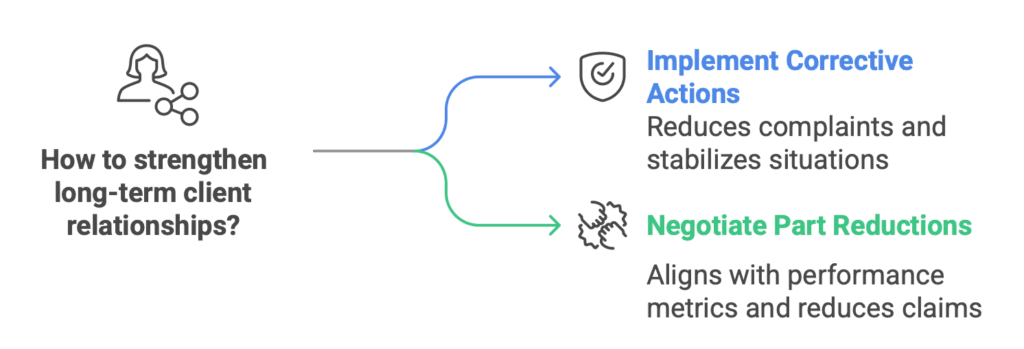One of the plant key indicators is the complaints number from the customer. Additionally, some of them use an indicator referring to ppm.
One of the key indicators for a manufacturing plant is the number of customer complaints. Additionally, some organizations use a PPM (parts per million) indicator to track quality issues.
So, what are the key mistakes to avoid in complaints management? Let’s explore this in detail.
The role of customer complaints in Supplier-Client cooperation
Customer complaints are a critical element of the relationship between a supplier and a client. If they arise, they may be escalated in accordance with IATF section 9.1.2.1. This often happens when, even after implementing corrective actions (PCA), the client continues to report the same issue. In such cases, we are dealing with a recurrence, which indicates that a proper root cause analysis was not conducted.
How to use the right vocabulary in Complaints Management
Customer complaints often require careful handling, and a key part of this is using appropriate language. Why? Because maintaining a diplomatic tone is crucial to preserving the supplier-client relationship.
For example, when it is determined that the supplier is not responsible for the issue, avoid saying:
“The complained part has been damaged by the customer.”
Such a statement can significantly damage the supplier’s credibility. Instead, use a more neutral phrase like:
“The part was damaged outside the supplier’s production plant.”
This phrasing ensures clarity and avoids causing unnecessary friction. The customer is more likely to understand that the issue could have resulted from:
- The logistics service provider, often managed by the customer.
- The use of inappropriate packaging.
- Improper storage of products in the client’s incoming material warehouse.
- Mishandling parts when moving them from the warehouse to the production line.
- Incorrect assembly, such as using the wrong tightening sequence.
To go a step further, consider offering the client a joint line walk along their production process. This proactive approach can help identify the root cause and improve the overall relationship.
Building Long-Term Relationships Through Proactive Actions
By taking a collaborative approach, you can strengthen long-term relationships with your clients.
 This strategy can also be useful during future negotiations, such as:
This strategy can also be useful during future negotiations, such as:
- Reduce the number of complaints for the same defect type by implementing corrective actions (PCA) and allowing the situation to stabilize.
- Negotiating a reduction in the number of claimed parts, especially if your organization also tracks PPM indicators as part of its performance metrics.
The Importance of Involving Customer Representatives
In some cases, involving a customer representative can be a decisive factor in resolving disputes. This is particularly useful for reports where the manufacturing site is not responsible for the issue.
By engaging a representative, such as a Supplier Quality Engineer (SQE) or other designated individual, you can jointly conduct an in-depth analysis. When the customer sees that their representative participated in the investigation, they are more likely to withdraw unjustified complaints. This collaborative approach not only resolves disputes more effectively but also strengthens trust between both parties.
Analyze the Customer complaints procedure
Some customers, such as Stellantis xFCA have specific response times defined within their complaint procedures. For instance, when requesting to reject a claim, the allotted response time might be 10 business days, as specified in section H19 of procedure 08018.
It’s essential to adhere to these timelines. If the analysis takes longer than expected, proactively request an extension from the client. This demonstrates professionalism and respect for their process.
Never Argue with a Client
This is a fundamental rule: never argue with a client, even if you are confident that you are right and they are mistaken. Engaging in an argument shifts the interaction from a constructive discussion to an emotional conflict, which is counterproductive.
If you notice that the conversation is veering off course or becoming contentious, consider the following strategies:
- Reschedule the discussion: Suggest transferring the meeting to a later time or date. This provides an opportunity to regroup with internal teams, such as engineering or quality departments, to gather additional constructive arguments.
- Propose a joint analysis: In cases of disagreement about the conclusions of an analysis, involve the client’s representative in a collaborative review. This approach fosters mutual understanding and often leads to a resolution.
Final Thoughts
Effective communication and adherence to complaint procedures are key to maintaining strong relationships with customers. By avoiding arguments and ensuring timely responses, you can navigate even challenging situations with professionalism.
I hope this article has provided valuable insights into what mistakes to avoid when handling customer complaints and how to prepare effective communication strategies.
Dariusz Kowalczyk


